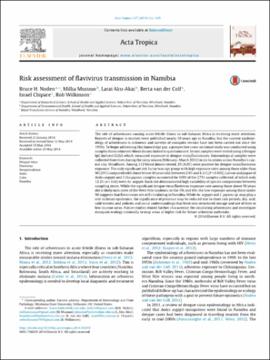| dc.contributor.author | Noden, Bruce H. | |
| dc.contributor.author | Musuuo, Milka | |
| dc.contributor.author | Aku-Akai, Larai | |
| dc.contributor.author | van der Colf, Berta | |
| dc.contributor.author | Chipare, Israel | |
| dc.contributor.author | Wilkinson, Rob | |
| dc.date.accessioned | 2022-04-12T13:53:13Z | |
| dc.date.available | 2022-04-12T13:53:13Z | |
| dc.date.issued | 2014-05-25 | |
| dc.identifier | oksd_noden_riskassessment_2014 | |
| dc.identifier.citation | Noden, B. H., Musuuo, M., Aku-Akai, L., van der Colf, B., Chipare, I., & Wilkinson, R. (2014). Risk assessment of flavivirus transmission in Namibia. Acta Tropica, 137, pp. 123-129. https://doi.org/10.1016/j.actatropica.2014.05.010 | |
| dc.identifier.uri | https://hdl.handle.net/11244/335191 | |
| dc.description.abstract | The role of arboviruses causing acute febrile illness in sub-Saharan Africa is receiving more attention. Reports of dengue in tourists were published nearly 10 years ago in Namibia, but the current epidemiology of arboviruses is unknown and surveys of mosquito vectors have not been carried out since the 1950s. To begin addressing this knowledge gap, a prospective cross-sectional study was conducted using samples from volunteer blood donors linked to questionnaire. Serum samples were tested using a Dengue IgG Indirect ELISA which measured exposure to dengue virus/flaviviruses. Entomological samples were collected from tires during the rainy season (February-March 2012) in six locations across Namibia's capital city, Windhoek. Among 312 blood donors tested, 25 (8.0%) were positive for dengue virus/flavivirus exposure. The only significant risk factor was age group with high exposure rates among those older than 50 (29%) compared with those below 40 years old (between 2.9% and 8.3%) (P< 0.002). Larvae and pupae of Aedes aegypti and Culex pipiens complex accounted for 100% of the 2751 samples collected, of which only 12.2% (n=. 336) were Ae. aegypti. Each site demonstrated high variability of species composition between sampling times. While the significant dengue virus/flavivirus exposure rate among those above 50 years old is likely indicative of the West Nile epidemic in the 70s and 80s, the low exposure among those under 50 suggests that flaviviruses are still circulating in Namibia. While Ae. aegypti and C. pipiens sp. may play a role in future epidemics, the significance of presence may be reduced due to short rain periods, dry, arid, cold winters and policies and social understandings that limit non-structured storage and use of tires in low income areas. Future studies should further characterize the circulating arboviruses and investigate mosquito ecology nationally to map areas at higher risk for future arbovirus outbreaks. | |
| dc.format | application/pdf | |
| dc.language | en_US | |
| dc.publisher | Elsevier BV | |
| dc.relation.ispartof | Acta Tropica, 137 | |
| dc.relation.uri | https://www.ncbi.nlm.nih.gov/pubmed/24865792 | |
| dc.rights | This material has been previously published. In the Oklahoma State University Library's institutional repository this version is made available through the open access principles and the terms of agreement/consent between the author(s) and the publisher. The permission policy on the use, reproduction or distribution of the material falls under fair use for educational, scholarship, and research purposes. Contact Digital Resources and Discovery Services at lib-dls@okstate.edu or 405-744-9161 for further information. | |
| dc.subject.mesh | Adolescent | |
| dc.subject.mesh | Adult | |
| dc.subject.mesh | Aedes | |
| dc.subject.mesh | Age Factors | |
| dc.subject.mesh | Animals | |
| dc.subject.mesh | Antibodies, Viral | |
| dc.subject.mesh | Cross-Sectional Studies | |
| dc.subject.mesh | Culex | |
| dc.subject.mesh | Dengue Virus | |
| dc.subject.mesh | Disease Transmission, Infectious | |
| dc.subject.mesh | Entomology | |
| dc.subject.mesh | Enzyme-Linked Immunosorbent Assay | |
| dc.subject.mesh | Female | |
| dc.subject.mesh | Flaviviridae Infections | |
| dc.subject.mesh | Humans | |
| dc.subject.mesh | Immunoglobulin G | |
| dc.subject.mesh | Male | |
| dc.subject.mesh | Middle Aged | |
| dc.subject.mesh | Namibia | |
| dc.subject.mesh | Prospective Studies | |
| dc.subject.mesh | Risk Assessment | |
| dc.subject.mesh | Seroepidemiologic Studies | |
| dc.subject.mesh | Surveys and Questionnaires | |
| dc.subject.mesh | Young Adult | |
| dc.title | Risk assessment of flavivirus transmission in Namibia | |
| dc.date.updated | 2022-04-07T14:30:54Z | |
| osu.filename | oksd_noden_riskassessment_2014.pdf | |
| dc.description.peerreview | Peer reviewed | |
| dc.identifier.doi | 10.1016/j.actatropica.2014.05.010 | |
| dc.description.department | Entomology and Plant Pathology | |
| dc.type.genre | Article | |
| dc.type.material | Text | |
| dc.subject.keywords | Aedes | |
| dc.subject.keywords | Culex | |
| dc.subject.keywords | Dengue virus | |
| dc.subject.keywords | Flavivirus | |
| dc.subject.keywords | Namibia | |
| dc.subject.keywords | Seroprevalence | |
| dc.subject.keywords | Rare Diseases | |
| dc.subject.keywords | Infectious Diseases | |
| dc.subject.keywords | West Nile Virus | |
| dc.subject.keywords | Prevention | |
| dc.subject.keywords | Vector-Borne Diseases | |
| dc.subject.keywords | Emerging Infectious Diseases | |
| dc.subject.keywords | Biodefense | |
| dc.subject.keywords | Vaccine Related | |
| dc.subject.keywords | Infection | |
| dc.subject.keywords | 3 Good Health and Well Being | |
| dc.subject.keywords | 06 Biological Sciences | |
| dc.subject.keywords | 11 Medical and Health Sciences | |
| dc.subject.keywords | Tropical Medicine | |
| dc.identifier.author | ORCID: 0000-0002-0096-370X (Noden, BH) | |
| dc.identifier.author | ScopusID: 6601968347 (Noden, BH) | |
| dc.identifier.author | ScopusID: 56198126800 (Musuuo, M) | |
| dc.identifier.author | ScopusID: 56198193500 (Aku-Akai, L) | |
| dc.identifier.author | ScopusID: 55482866500 (van der Colf, B) | |
| dc.identifier.author | ScopusID: 56147994900 (Chipare, Israel) | |
| dc.identifier.author | ScopusID: 57222416885 (Wilkinson, R) | |
